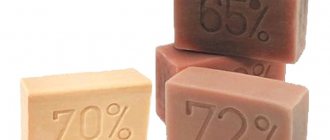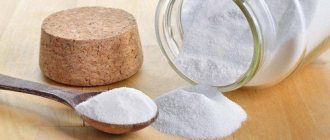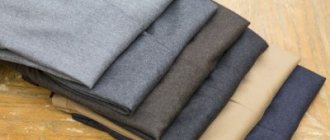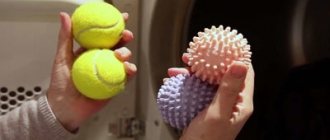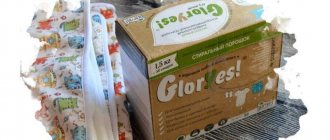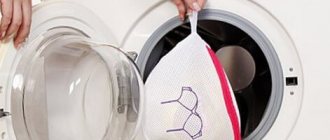Probably, almost all of us have at least one soft and pleasant-to-touch mohair item. Warm sweaters, dresses, sweaters, suits and even coats are made from the wool of Angora goats. Mohair is also used for rugs, bedspreads, curtains, blankets and carpets.
Caring for these woolen items is not easy. Washing them requires special delicacy. Of course, it is possible to resort to dry cleaning services, but in this case you need to know that mohair products wear out faster when dry cleaned. Therefore, it is better to choose regular washing.
Conditions for washing mohair items: hand wash and machine wash
– I bought myself several mohair things – I really liked them.
I’ve never worn mohair before, so I don’t know how to care for it. I'm interested in how and what to wash mohair with. And how can you fluff it up if it becomes matted during washing? – You can wash mohair items in two ways – by hand and in a machine. Machine washing is allowed only if it is permitted by the manufacturer - there must be a corresponding mark on the product label. If we are talking about homemade mohair items, then they should be knitted from thick, dense threads.
Even if machine washing is allowed, hand washing is always recommended if possible . It is less traumatic and this is an important condition, since mohair is a very soft and delicate material.
If a mohair item has a voluminous collar, it must be basted with the main fabric to prevent stretching.
Since mohair is natural wool, it can become deformed when washed - shrink or stretch. To prevent this from happening, you must follow all recommendations and not violate the temperature regime.
How to wash mohair by hand:
- If there are stains on your clothes, carefully treat them with a swab dipped in soapy water.
- For washing, use gel for wool fabrics or ordinary shampoo. Pet shampoo is also allowed.
- Fill a large bowl with water. For fine and openwork yarn, the temperature should not be higher than 30 °C. For dense options, a temperature of 35-40 ° C is allowed, but no more.
- For severe stains, you can soak the mohair, but only for 10-15 minutes.
- Wash items using gentle squeezing movements. Mohair should not be rubbed or twisted.
- Rinse, changing the water in the basin several times to clean water. The water temperature should remain constant. To keep mohair shiny and soft, add a little conditioner or glycerin to the water during the last rinse.
How to machine wash mohair:
- Turn the item inside out.
- Place in a laundry bag or old pillowcase.
- Set the mode – delicate or “wool”.
- Water temperature – 30 °C.
- Turn off spinning and drying.
- Dry mohair items in a straightened state on a terry towel, which is changed when wet.
Sometimes it happens that mohair falls off and needs to be fluffed up. There are two ways to do this :
- After most of the moisture has drained from the mohair, wrap it in a bag and put it in the freezer for 2-3 hours. Then take it out, spread it out and dry it.
- Hang the dried product on hangers over the bathtub and turn on the hot water. The resulting steam will straighten the wool. Afterwards, the mohair needs to be combed with a massage brush.
Below you can find reviews of laundry detergents and useful articles on the topic.
Source
Knitted hat - washing rules
If the product is made of synthetic thread, then it should be washed as indicated on the label. If you knitted the hat by hand, then recommendations for threading should be found on the label of the skein. A fairly simple way to wash a knitted hat is to put it in a washing bag and put it in the washing machine. In this case, a delicate mode is started, and the detergent composition is taken in accordance with the characteristics of the yarn. You need to turn off the spinning and drying, otherwise the headdress will shrink and lose its shape. But still, hats that are made of natural wool should not be washed in a washing machine - the machine is not worth it.
Wool can be easily washed by hand, especially in a special shampoo for this type of thread.
If the product is too dirty, it can be soaked for a couple of hours in a suitable detergent. You can soak the wool in cold water with a little vinegar added - this way the hat will certainly not fade.
To wash a hat by hand, take lukewarm water into a small basin, dilute the detergent in it and immerse the product. The cap is carefully washed by hand, being careful not to tug or pull. Heavily contaminated areas are lightly rubbed. To prevent the product from shrinking or fading, you need to maintain the temperature. Wool does not like hot water and should be washed at +30. Please note that this thread does not tolerate temperature changes, so it is washed and rinsed in water at the same temperature. It is strictly forbidden to wash wool thread in bleach or powder with enzymes. Biopowders can ruin a product in just one wash.
Wring out such things very carefully so as not to deform them. It is best to remove the product from the water, lightly squeeze it by hand over the bathtub, and then lay it out on a terry towel and roll it up. This way the towel will absorb excess moisture and you can lay out the cap to dry. There is a little secret to proper drying - if the hat is knitted from mohair or fluffy wool, then it can be wrapped in a bag and put in the freezer for a couple of hours. Then the headdress will become even more fluffy and voluminous.
Preliminary preparation
Before immersing in water, the product must be prepared as follows:
- Remove the pellets, which often appear in the area of the sleeves and sides during prolonged wear, using a razor or other convenient method. It is prohibited to pull them out with your hands.
- Sew up the loop slits with a “forward needle” seam, baste the large collar to the main fabric, then these parts of the model will not stretch.
- Remove stains by blotting them with a swab soaked in one of the cleaning products (the choice depends on the type of contamination):
- in soap solution, dishwashing detergent, alcohol - to remove oil;
- in warm glycerin - to clean traces of juice, wine, herbs;
- lemon juice - if stains from tea or coffee are detected.
Handwash
Mohair yarn is delicate and high maintenance. The finest Kid mohair and royal mohair with very long pile are especially capricious. Products made from these types of yarn are recommended to be washed exclusively by hand. The following requirements apply to hand washing:
Find out what water temperature the manufacturer recommends. If there is no label, water is poured into the basin according to the standard:
- for gossamer scarves and thin openwork jumpers, it should not be hotter than 35° (optimally 30°);
- for outerwear made of thick Goating and Adult Mohair, the temperature (if heavily soiled) can be increased to 40°.
If you raise the water temperature above the recommended one, the product will lose its shape.
An important issue is the choice of detergents. Suitable for hand washing:
- shavings of baby soap, dissolved in water and whipped into foam (alkaline laundry soap makes the fabric feel matted);
- liquid wool detergent (powder will be difficult to rinse out);
- shampoo.
Do not use detergents containing chlorine. Do you need to return the model to white? Add 2 tsp to the water. Boers.
If the water is hard, it should be softened, as due to excess salts, mohair loses its silkiness. To do this, add a purchased water softener or baking soda (10 g per 10 l) to the detergent. Before lowering the product into the basin, mix the solution thoroughly.
Mohair fabric does not tolerate prolonged contact with water, so soaking time should not exceed a quarter of an hour. In this case, only one item is washed at a time.
Intense friction and twisting are the enemies of any wool. During washing, the product is only slightly squeezed with your palms.
For rinsing, use water at the same temperature as for the main wash. Woolen models should be rinsed several times, changing the water. During the last rinse, add to the container:
- for light-colored products - fabric or hair conditioner or 1 tsp. glycerin;
- for colored people – 9% table vinegar (5 ml per 10 l) or pre-dissolved citric acid;
- a mixture of ammonia (45 ml), turpentine (15 ml) and vodka (30 ml), if the surface is matted.
The clean item is immediately removed from the water and placed in a dry container for 30-40 minutes. The canvas is periodically slightly compressed, draining the liquid from the basin.
Working with fabric
Which sewing machine to choose: the best models from budget to computerized
Review of models for industrial and domestic use
The best models for home and production according to customer reviews
Let's take a closer look at the nuances of returning
Did you like the article? Rate it:
– I bought myself a mohair hat, very beautiful. I wore it all winter, and now the question arose of how and what to wash it with. I’ve never worked with mohair before - I’m very afraid of ruining the hat. What to do?
It is best to wash any mohair products by hand - this is the safest option, since mohair is a soft and delicate material that requires delicate care.
When washing, use only liquid detergents for delicate fabrics, without bleaching or other aggressive components in the composition . The powder cannot be used because it is poorly washed out of mohair fibers, which requires additional active rinsing. As a result, the structure of the yarn may be damaged. If you don't have liquid detergent, use regular hair shampoo.
Algorithm for washing a mohair hat by hand:
- Mohair should not be soaked.
- Mohair products should be washed and rinsed in water at the same temperature. Temperature fluctuations can have a detrimental effect on the material, ruining it.
- Pour water into a large basin. The water temperature should not exceed 35 °C, and if the hat is made of fine mohair, then 30 °C.
- Dilute detergent or shampoo in water. There is no need to pour the product directly onto the mohair.
- Place the hat in the basin and carefully wash it using gentle, lightly pressing movements. Do not rub or twist under any circumstances, otherwise the wool will mat and the hat will become deformed.
- Only one item needs to be washed at a time. You cannot wash several mohair items together, even if they are the same color.
- Rinse the hat, replacing the used water with clean water several times. During the last rinse, add a little hair conditioner or vinegar to the water at the rate of 5 ml per 10 liters of water. This will help the mohair maintain its shine and softness.
- Lightly wring out the hat and wrap it in a towel to absorb excess moisture. Then spread out on a flat surface, turning occasionally, until completely dry.
If you decide to machine wash your mohair hat:
- There should be a machine washable symbol on the hat's label.
- The hat should be made of thick mohair.
- The hat must be turned inside out and placed in a special bag for washing.
- Select manual or delicate wash mode, temperature not higher than 35 °C.
- The spin and dry function must be turned off. Even when machine washing, it is better to rinse mohair items by hand.
Below you can find instructions on how to remove various stains, as well as reviews of laundry products and fabric care equipment.
— Anna Titova Dry cleaning technologist
Machine washable
In an automatic washing machine, mohair items are washed only in two cases:
- if permitted by the manufacturer;
- if the fabric is knitted from dense threads.
It is not advisable to keep mohair in liquid for a long time and exert active mechanical influence on it. And with machine washing, both are inevitable. If you still decide to wash the item in the machine, you should listen to these recommendations:
- As with the manual cleaning option, each product is cleaned separately.
- If powder rather than liquid detergent is placed in the cuvette, it is best to turn on the “baby comfort” mode, which involves double rinsing.
- Before putting it into the drum, the coat or jumper is turned inside out, then carefully folded with the sleeves inward and placed in a mesh laundry bag. This will preserve not only the product, but also the mechanism of the machine, since it can become clogged with lint.
- The panel sets the “delicate wash” or “wool” mode. The spin should be minimal (no more than 500 revolutions). If the item is small, it is better to turn it off. The same needs to be done with drying.
Application
A wide variety of things are made from mohair. The first in popularity are, of course, sweaters. They turn out very warm, fluffy, incredibly cozy and beautiful. Scarves, hats and mittens will also keep you warm in cold winters.
Thin angora threads are used to weave fabric for sewing coats and jackets. The surface of this fabric with fluff is very soft.
Craftswomen knit airy tunics, blouses and shawls from the finest kid wool. Openwork knitting is especially popular, in which the thread consumption is much less, and heat is retained in the same way as with dense knitting.
Thicker types of Angora yarn are used to produce blankets, blankets, warm slippers, scarves, and pillows.
How to wash hand knitted mohair.
If you properly care for mohair knitted items, they will last for years without losing their appearance. The rules are like this.
1. Hand wash only. You can't soak it.
2 . Wash and rinse in water at the same temperature. Thermal shock is death for a mohair product. The water temperature should be no higher than 30 degrees.
3. For washing, use only special detergents, preferably liquid ones. You can use the simplest hair shampoo.
4. After rinsing, lightly wring out the product without twisting it and put it in the sink to let the water drain; it will be better if you roll the product in a towel in a ball (again, to avoid thermal shock from contact with a cold sink). Then you can squeeze it in a centrifuge, BUT at low speeds - up to 500, but it’s better to do without it and remove excess moisture from the product with a towel.
5. Dry first on a dry towel on a hard surface or on a wire rack. In this case, it is necessary to straighten the product, giving it the correct shape, pulling and placing it in the right places and from time to time turning it over and inside out. DO NOT USE AN ELECTRIC DRYER.
6. Shake the dried product vigorously, like a fur skin. You cannot comb or pluck a mohair product - this will not make it fluffier, rather the opposite. The fluffiness rises in all its glory while wearing the product.
7. A product knitted from mohair in satin stitch or openwork can be ironed with a not very hot iron after drying. The surface will become smoother, the openwork more beautiful. At the same time, move the iron in one direction, from bottom to top, without pressing.
If a knitted item made of mohair begins to prick, then it’s time to wash it.
Source
How to unravel felted wool
The process of dissolving an old knitted item begins with preparatory work.
Product preparation
Initially, you should remove all additional parts : patch pockets, belts, straps,
buttons, etc. Then you should thoroughly wash the product in warm water and dry it, but not completely.
IMPORTANT! It is necessary that the product remains slightly damp! This way the threads unravel much easier, without clinging or getting tangled with each other.
Completing of the work
The next step is to determine in which direction the item was knitted
: from bottom to top or vice versa.
ADVICE ! If you started knitting from the bottom, then first the collar is ripped off, then the sleeves, and at the end the seams on the shoulders and sides of the product are cut.
On each knitted piece you should find the end of the woolen thread, and start unraveling the clothes from there.
There is the least amount of hassle when unraveling home knitted clothes. There will be more problems with a factory-made product: it can be knitted entirely or in parts, and then sewn together. It is possible that the factory first wove knitted fabric, and only then cut out clothing parts from it and sewed them together. In this case, all the threads will be cut, and a long skein of yarn can be obtained from them only by tying their ends.
Attention! When unraveling, the threads need to be wound into loose balls. Worn threads should be immediately separated from more or less whole threads in order to use them in subsequent knitting for different areas.
Secrets and tricks
- Tie the individual threads together with flat knots. At the same time, leave the ends of these threads at least a couple of centimeters long so that you can later thread them with a crochet hook.
- New threads are added to the worn threads for strength, even in a variety of colors. The result is a melange yarn that is stronger and more elegant.
- For items made from very tangled and very fluffy woolen threads, use the following product to make them easier to unravel . Warm water mixed with hair balm or shampoo is poured into a basin. Place the knitted product there for 15–20 minutes. Then, without removing it from the water, they carefully unravel it into threads.
- When the item is too felted and this method still does not give an effect, you can try washing the woolen item in a machine with boiling water and cutting out all the fragments that cannot be unraveled.
LiveInternetLiveInternet
—Categories
- Knitting (77)
- Sweaters and cardigans (32)
- Dresses (15)
- Knitting for children (9)
- accessories (9)
- T-shirts and tops (4)
- coat (2)
- Skirts (2)
- socks, stockings, slippers (1)
- Cooking (33)
- snacks (8)
- baked goods (6)
- dessert (2)
- salads (2)
- winter preparations (1)
- drinks (1)
- Scrap, clip art (23)
- Children (20)
- toys (6)
- we sew for children (6)
- health (2)
- entertaining and exciting (1)
- sewing (12)
- handicrafts (2)
- Handicrafts (10)
- Design (4)
- kitchen (1)
- For the garden (1)
- Jewelry (2)
- Useful things (2)
- New Year (2)
- Modeling (1)
- Easter (1)
- Beauty and health (1)
- Cats (1)
—Search by diary
—Subscription by e-mail
-Statistics
Secrets of caring for a mohair product
It is advisable to wash ONLY by hand, using wool products, or in the absence of these, mild hair shampoo; It is necessary to wash and rinse in water of the same temperature, about 35 degrees.
Do not pour washing powder directly onto the item, as this may ruin the color.
When washing, items should not be rubbed or twisted.
Items made from mohair should not be soaked; they should be washed separately from each other.
If the item becomes matted during washing, then it should be soaked in 10 liters of water, to which three tablespoons of ammonia, two tablespoons of vodka and one tablespoon of turpentine should be added.
When rinsing things, you should add a little vinegar or citric acid to preserve the color scheme. And to add shine to the fabric, you can add a couple of tablespoons of glycerin.
You can wring it out using terry towels; the wet product should be combed well with a brush.
After washing, mohair items should be dried at room temperature (avoiding direct rays and heating devices).
Steam will help to smooth out a mohair item by hanging it over a basin of hot water for a while or using a soft lining at a distance and lightly treating the item with iron steam without touching it with the sole.
To keep your mohair item soft and fluffy when it dries, put it in a bag and place it in the freezer for 2 hours. Then carefully remove and let it thaw.
If the product is small, then by stretching it you will not be able to make it larger: after a while it will again take its original shape.
Mohair items should be stored on hangers with soft hangers after all the buttons/zippers have been fastened (thanks to this, items will return to their original shape within 24 hours). Or neatly folded at the seams in a well-ventilated room or closet.
“Washing a real sweater is like bathing a baby: the end result is a clean, beautiful, good-smelling creation and a lot of satisfaction!”
Elizabeth Zimmerman
| Categories: | Utilities |
Tags:
mohair care tips
Cited 1 time Liked by 1 user
Source
Types of mohair yarn
Today there are three types of mohair. They differ from each other in the processing method and properties.
- Kid Mohair - produced from the wool of the youngest kids after their first haircut. This is the most delicate and thin type of yarn, and also the most expensive.
- Goatling Mohair is made from the wool of two-year-old goats, whose hairs are already thicker than those of the youngest kids.
- Adult Mohair is mohair made from the hair of adult goats. Compared to the first two types, this one is coarser and thicker.
Conditions for washing mohair items: hand wash and machine wash
Probably, almost all of us have at least one soft and pleasant-to-touch mohair item. Warm sweaters, dresses, sweaters, suits and even coats are made from the wool of Angora goats. Mohair is also used for rugs, bedspreads, curtains, blankets and carpets.
Caring for these woolen items is not easy. Washing them requires special delicacy. Of course, it is possible to resort to dry cleaning services, but in this case you need to know that mohair products wear out faster when dry cleaned. Therefore, it is better to choose regular washing.
Popular animal fabrics
Alpaca is a gift from the cutest creatures walking along the steep slopes of the harsh Andes
Ratin is a natural prestigious woolen coat fabric, distinguished by its special aristocracy
Brocat is a spectacular expensive fabric. Why is it important to care for her properly?
Afgalen is a soft, dense material made from natural wool, practically free of flaws.
Angora is a warm fabric made from the wool of the Angora goat or Angora rabbit. Is it possible to call mohair, suprem, melange, soft and lana angora?
Satin and its 6 varieties - the appearance of silk, the character of cotton
Kid mohair is the softest yarn that is much talked about and is coming back into fashion.
Woolen fabric: what types of woolen fabrics are divided into. Characteristics of species and properties
Crepe satin is a unique fabric that combines the properties of two materials. A good option for sewing bright and expressive outfits
Ultrastep - why is ultrasound used to make this fabric?
Hand wash
IMPORTANT! Mohair items should not be pre-soaked.
For washing, you can use any delicate liquid detergent composition. If you don't have liquid washing gel, use regular shampoo to wash your hair. Shampoo is good for washing pets. If you decide to wash with washing powder, do not pour it directly onto your clothes. Prepare a soap solution no higher than 30°C and dip the woolen product into it.
It is not recommended to strongly wrinkle or rub knitted items so that the knitting structure is not damaged and it does not stretch.
If long soft wool becomes matted during washing, you can rinse the product in a solution of 10 liters of cool water, 3 tablespoons of ammonia, 2 tablespoons of vodka and one spoon of turpentine. Mohair treated in this solution will straighten.
To prevent the wool from becoming faded and shiny after washing, add a couple of tablespoons of glycerin to the water. If the mohair is colored, to preserve the brightness of the color, you can add a little table vinegar.
Features of washing in a washing machine
Woolen items can also be washed in a washing machine, provided that the wash cycle is delicate. As a rule, the wool is washed manually. The temperature should not be higher than 30°C.
Since mohair products are quite voluminous and fluffy, they should be washed only with delicate liquid detergents that do not contain bleaching components. Why it is not recommended to use regular washing powder because it does not rinse well. To sufficiently rinse the powder from the yarn fibers, you need to add at least a few extra rinses. And this can disrupt the structure of a knitted fluffy item. Before loading into the drum, the product should be turned inside out and all buttons, if any, should be fastened.
To make mohair even more soft, we recommend adding a little glycerin to the washing machine compartment.
Immediately after the main wash, you need to remove the wool item from the washing machine. The spinning and drying processes should be done manually, without using a machine.
Conditions for washing mohair items: hand wash and machine wash
– You can wash mohair items in two ways – by hand and in a machine. Machine washing is allowed only if it is permitted by the manufacturer - there must be a corresponding mark on the product label. If we are talking about homemade mohair items, then they should be knitted from thick, dense threads.
Even if machine washing is allowed, hand washing is always recommended if possible . It is less traumatic and this is an important condition, since mohair is a very soft and delicate material.
If a mohair item has a voluminous collar, it must be basted with the main fabric to prevent stretching.
Since mohair is natural wool, it can become deformed when washed - shrink or stretch. To prevent this from happening, you must follow all recommendations and not violate the temperature regime.
How to wash mohair by hand:
- If there are stains on your clothes, carefully treat them with a swab dipped in soapy water.
- For washing, use gel for wool fabrics or ordinary shampoo. Pet shampoo is also allowed.
- Fill a large bowl with water. For fine and openwork yarn, the temperature should not be higher than 30 °C. For dense options, a temperature of 35-40 ° C is allowed, but no more.
- For severe stains, you can soak the mohair, but only for 10-15 minutes.
- Wash items using gentle squeezing movements. Mohair should not be rubbed or twisted.
- Rinse, changing the water in the basin several times to clean water. The water temperature should remain constant. To keep mohair shiny and soft, add a little conditioner or glycerin to the water during the last rinse.
How to machine wash mohair:
- Turn the item inside out.
- Place in a laundry bag or old pillowcase.
- Set the mode – delicate or “wool”.
- Water temperature – 30 °C.
- Turn off spinning and drying.
- Dry mohair items in a straightened state on a terry towel, which is changed when wet.
Sometimes it happens that mohair falls off and needs to be fluffed up. There are two ways to do this :
- After most of the moisture has drained from the mohair, wrap it in a bag and put it in the freezer for 2-3 hours. Then take it out, spread it out and dry it.
- Hang the dried product on hangers over the bathtub and turn on the hot water. The resulting steam will straighten the wool. Afterwards, the mohair needs to be combed with a massage brush.
Below you can find reviews of laundry detergents and useful articles on the topic.
How to dry mohair and can it be ironed?
An item hung on a rope, hanger or the back of a chair will stretch out, but the mark of the fold will remain on it.
Mohair should only be dried in a horizontal position.
- When the canvas swells in the basin, the model is wrapped in a towel and gently squeezed so that water is absorbed into the fabric.
- The product is unrolled and laid out on the table, with a cloth that absorbs water well placed under it. The mohair is turned over during the drying process.
- Do not expose mohair items to bright sunlight, hang them on a radiator, or use hot air.
Ironing fabric, especially openwork knitted fabric, is highly discouraged. If there is an urgent need for this, the model is turned inside out and processed with an iron set to minimum power through a thin fabric. But there are many ways to iron things without an iron; for example, a steam bath is suitable for sweaters and other mohair items.
To make the pile fluff up again, comb it with a soft brush, put the item in the freezer for 2 hours or hold it over steam (hang it over a container of boiling water or turn on very hot water).
Useful tips
Remember that even new products need to be washed after knitting or purchasing. After all, when knitting, especially from light wool, the item gets dirty, and washing refreshes its appearance, cleans the new yarn of its protective coating, fluffs it up and makes it less prickly. If you don’t want to do laundry, then at least steam it and dry it flat.
It is recommended to hang new clothes or after the first wear in the bathroom so that they can straighten out in high humidity.
To give a matted item its original appearance, you need to soak it in water with 2-3 tbsp. spoons of ammonia, 2 tbsp. l. vodka and 1 tbsp. l. turpentine. Small stains on woolen items can be easily removed with a soft brush and soapy water.
Mohair clothes should be hung on soft hangers for storage.
Proper care of woolen items will allow you to preserve the original beauty of your items for a long time and increase their wear life.
Care
In order for mohair products to delight you with beauty and warmth for a long time, you must follow the recommendations:
- When purchasing clothing or knitting yarn, check the manufacturer's care instructions.
- If the item gets wet, you need to dry it flat out, in a well-ventilated area away from heating appliances.
- Stains and dirt are carefully removed with a damp sponge.
- Dry cleaning by a specialized service is recommended.
- In some cases, it is possible to wash items in a delicate cycle using special shampoos for washing woolen fabrics without twisting and spinning in the machine. Drying is done at room temperature. Hand-knitted terry cloth is not washable and requires dry cleaning. Important! Mohair items should not be dried on radiators.
- Mohair clothes do not need to be ironed. They rarely wrinkle, and in this case steaming is used.
- Items that have previously been dry-cleaned or washed and dried are put away for storage. They are carefully folded and packaged in special cases or bags. Regular ventilation and the use of moth repellents are required.
How to revive used yarn: step-by-step instructions
Today I want to talk about a problem that some people encounter, but do not know how to cope with, namely, bringing yarn from unraveled items into proper condition.
Sometimes it turns out that you knitted something from beautiful, high-quality, expensive yarn. We wore it with pleasure for some time, after which it went out of fashion, stretched out, got boring, and so on. And the product lies on the shelf, collecting dust, and the hand cannot be bothered to throw it away, because money and colossal work have been invested, and there is no benefit, only sadness every time you open the closet.
Naturally, sooner or later it will occur to everyone to unravel the product and knit something else, especially since the yarn is luxurious with a rich composition. With difficulty we find the end of the thread carefully hidden in the seam, unravel it and... we get a curly, wrinkled, useless substance that looks like an anak or the wig of a famous singer from the 80s.
The fact is that during use we wash and dry the item several times. The threads are fixed in this position and when unraveled they become curly and thinner, as if caked. I initially knitted a sweater on needles No. 6, and after unraveling the threads were suitable for a maximum of No. 4.5. And the most unpleasant thing about all this is that if you knit something from such yarn, the fabric turns out to be clumsy, with loose loops, and looks sloppy and cheap. And nothing can be done about it. As a result, the following picture emerges: you again spent time and effort, but you ended up with something that can only be worn under a jacket for warmth. Well, okay, as long as the yarn doesn’t lie around.
But I have good news: threads can be revived! Of course, they still won’t be exactly like new, but they will become much better and smoother. And if you also choose a pattern that hides the unevenness of the fabric, then you can get a completely decent thing that you won’t be ashamed to wear to a party.
How to do it?
1. Unravel the knitted fabric. You don't have to wrap it in a ball. You will get a lush slide like the one in the title photo.
2. Place the end of the thread in the notch between the thumb and index finger of your left hand, bend it at the elbow and begin to wind the thread around it, with your right hand facing away from you. As a result, you should end up with a ring, one end on your elbow and the other on your hand between your thumb and index finger. In this case, the thread tension should not be too tight or weak. It's better to stick to the middle here.
3. Carefully remove the ring of yarn from your hand without losing the end of the yarn. Take a few threads and tie your yarn ring in 2-3 places. Remember which thread the end of the yarn came under, otherwise later, after processing, it will be extremely difficult for you to find it. You need to tie a ring of yarn so that it remains a ring and does not get lost in the process of resuscitation into a homogeneous pile of threads that cannot be untangled. At the same time, you cannot tighten the fixing threads too much, as a dent may remain on the yarn. But if you tighten it very loosely, the yarn will simply fall out of them and again get tangled.
4. Next, we begin steaming the yarn. It's good if you have a slow cooker, I have one here.
Pour water into it, insert a plastic steam basket, put yarn in it and set the “steam” mode for about half an hour. There should not be too much water, otherwise when it boils it will start to fall into the basket and wet the threads. If there is too little of it, it will quickly boil and you will have to add more and wait for it to boil again.
Handwash
Mohair yarn is delicate and high maintenance. The finest Kid mohair and royal mohair with very long pile are especially capricious. Products made from these types of yarn are recommended to be washed exclusively by hand. The following requirements apply to hand washing:
Find out what water temperature the manufacturer recommends. If there is no label, water is poured into the basin according to the standard:
- for gossamer scarves and thin openwork jumpers, it should not be hotter than 35° (optimally 30°);
- for outerwear made of thick Goating and Adult Mohair, the temperature (if heavily soiled) can be increased to 40°.
If you raise the water temperature above the recommended one, the product will lose its shape.
An important issue is the choice of detergents. Suitable for hand washing:
- shavings of baby soap, dissolved in water and whipped into foam (alkaline laundry soap makes the fabric feel matted);
- liquid wool detergent (powder will be difficult to rinse out);
- shampoo.
Do not use detergents containing chlorine. Do you need to return the model to white? Add 2 tsp to the water. Boers.
If the water is hard, it should be softened, as due to excess salts, mohair loses its silkiness. To do this, add a purchased water softener or baking soda (10 g per 10 l) to the detergent. Before lowering the product into the basin, mix the solution thoroughly.
Mohair fabric does not tolerate prolonged contact with water, so soaking time should not exceed a quarter of an hour. In this case, only one item is washed at a time.
Intense friction and twisting are the enemies of any wool. During washing, the product is only slightly squeezed with your palms.
For rinsing, use water at the same temperature as for the main wash. Woolen models should be rinsed several times, changing the water. During the last rinse, add to the container:
- for light-colored products - fabric or hair conditioner or 1 tsp. glycerin;
- for colored people – 9% table vinegar (5 ml per 10 l) or pre-dissolved citric acid;
- a mixture of ammonia (45 ml), turpentine (15 ml) and vodka (30 ml), if the surface is matted.
Equipment and care products
Which washing machine to choose
How to iron with less effort and more comfort
How to quickly and easily iron anything
How to save time and quickly dry clothes and bedding
Review of classic, travel, wireless, smart and professional models
The best options in terms of quality, reliability and price
Rating of the best floor and ceiling models
The best dryers of ceiling, floor, wall types and models that can be installed on a bathtub or radiator
Choosing a product for adult and children's underwear
The best products for white, colored and children's underwear
Top 15 products for colored, white and children's underwear
Choose an antibacterial, biodegradable and hypoallergenic laundry detergent
Choosing the best laundry detergent
Choosing sheets for white, colored and children's linen
Top 15 best positions for washing adult and children's clothes
Rating of detergents for white and colored laundry
How to keep items made from natural fabrics clean and in shape
Choosing a product to quickly remove stains of any complexity
Rules for washing mohair
Mohair items can be washed either by hand or using a washing machine.
Before the procedure, carefully read the care instructions on the product label.
Let's find out how to wash mohair correctly so that something made from it will last you as long as possible and not lose its attractive appearance. By following simple rules, it is easy to wash a woolen jacket, sweater, dress, hat, etc.
Rules for machine washing mohair:
- Mohair items should be washed at a temperature no higher than 30 degrees.
- The selected powder, or better yet liquid product, should be suitable for woolen items.
- Place clothing in a mesh bag to prevent deformation.
- Set the “delicate wash” mode.
- It is recommended to pour 1 tbsp into the washing powder compartment. glycerin.
- If necessary, use spin at low speeds—less than 500.
Rules for hand washing mohair:
- You can't soak such things.
- Dissolve washing powder well in water; under no circumstances should you pour it directly onto the item, as this can ruin its color.
- It is allowed to use hair shampoo instead of powder.
- If there are several items, it is better to wash them separately.
- When washing by hand, the product should not be vigorously rubbed or twisted.
- Wring out the item carefully, preferably with a terry towel. Then place it in the sink, allowing excess water to drain, and after a while shake vigorously.
- During rinsing, it is advisable to pour vinegar or citric acid into the water to preserve the brightness of the color, as well as 1-2 tbsp. spoons of glycerin for softness and shine.
Proper drying
Typically, drying a knitted headdress takes several hours. Place the product on a flat surface with a terry towel. Change the towel to keep it dry. Under no circumstances should such items be dried on a radiator or near heat devices. Do not try to dry the item with a hairdryer. You should not dry your wool in the sun, hoping that it will dry out faster. The wool must dry only naturally. As you can see, there is nothing difficult about washing a knitted hat. Follow the rules for washing wool, dry the thread correctly, and then you can wear the hat for more than one season, and it will look like new for a long time.
Source
Cleaning methods
- If the wool is not very dirty, you can clean it using the dry cleaning method. But here you need to know that not all chemicals are suitable for cleaning it. Sometimes it is enough to treat a separate stain with a cotton swab and a soap solution warm to 30°C. Then rinse with clean water and blot the area on both sides with a terry towel. After cleaning, the product must be laid out on a cloth for subsequent drying.
IMPORTANT! Do not try to dry the treated wet area with a hair dryer.
- If the item requires special cleaning, you can contact a dry cleaner, but know that they will not give you a guarantee that the wool will not lose its appearance.
- If you decide to wash your mohair yourself, you can use either the hand washing method or the washing machine. But to do this, you need to know a few rules that will prevent you from ruining an expensive item.
Hat with pompom
There are two washing options here. If the pompom is made from the same yarn as the hat, then it must be washed together with the headdress. Most likely, the threads of the pompom have become matted due to washing, so after drying you will have to tidy it up and return it to its fluffiness. This is done with a wide-toothed comb, preferably made of wood. You can also straighten the pompom with a knitting needle, unraveling the thread. Do this carefully so as not to tear the threads out of the pompom.
With a pompom made of fur, things are much more complicated. Natural fur does not need to be wet, otherwise it can be damaged. You'll have to rip off the pompom. The headdress is washed in the described way, and the pompom is simply cleaned by dry cleaning, for example, using bran or starch.
What to do if you can’t rip off the pompom?
In this case, cunning housewives came up with their own way of washing. The pompom is simply tied tightly in film and tied tightly at the base. Then the cap is washed by hand, trying to prevent moisture from getting on the bag. Still, a little moisture may seep in, but usually this does not spoil the fur much. When the headdress is dry, the film is removed and the fur is combed with a brush.
